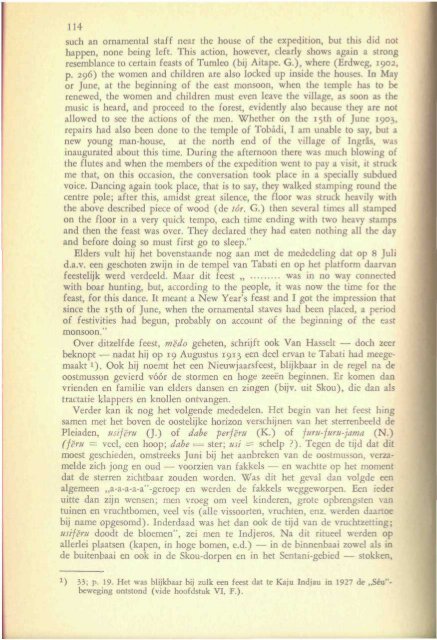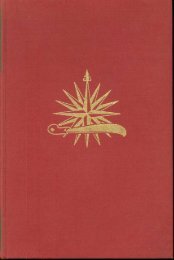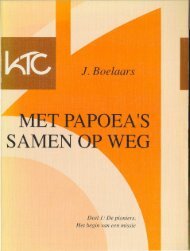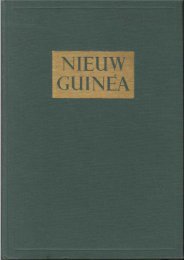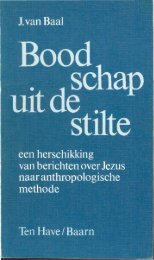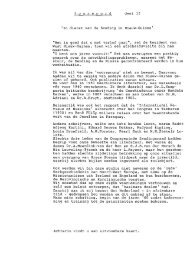Untitled - Stichting Papua Erfgoed
Untitled - Stichting Papua Erfgoed
Untitled - Stichting Papua Erfgoed
You also want an ePaper? Increase the reach of your titles
YUMPU automatically turns print PDFs into web optimized ePapers that Google loves.
114<br />
such an ornamental staff near the house of the expedition, but this did not<br />
happen, none being left. This action, however, clearly shows again a strong<br />
resemblance to certain feasts of Tumleo (bij Aitape. G.), where (Erdweg, 1902,<br />
p. 296) the women and children are also locked up inside the houses. In May<br />
or June, at the beginning of the east monsoon, when the temple has to be<br />
renewed, the women and children must even leave the village, as soon as the<br />
music is heard, and proceed to the forest, evidently also because they are not<br />
allowed to see the actions of the men. Whether on the 15th of June 1903,<br />
repairs had also been done to the temple of Tobadi, I am unable to say, but a<br />
new young man-house, at the north end of the village of Ingrås, was<br />
inaugurated about this time. During the afternoon there was much blowing of<br />
the flutes and when the members of the expedition went to pay a visit, it struck<br />
me that, on this occasion, the conversation took place in a specially subdued<br />
voice. Dancing again took place, that is to say, they walked stamping round the<br />
centre pole; after this, amidst great silence, the floor was struck heavily with<br />
the above described piece of wood (de tór. G.) then several times all stamped<br />
on the floor in a very quick tempo, each time ending with two heavy stamps<br />
and then the feast was over. They declared they had eaten nothing all the day<br />
and before doing so must first go to sleep."<br />
Elders vult hij het bovenstaande nog aan met de mededeling dat op 8 Juli<br />
d.a.v. een geschoten zwijn in de tempel van Tabati en op het platform daarvan<br />
feestelijk werd verdeeld. Maar dit feest „ was in no way connected<br />
with boar hunting, but, according to the people, it was now the time for the<br />
feast, for this dance. It meant a New Year's feast and I got the impression that<br />
since the 15th of June, when the ornamental staves had been placed, a period<br />
of festivities had begun, probably on account of the beginning of the east<br />
monsoon."<br />
Over ditzelfde feest, m do geheten, schrijft ook Van Hasselt — doch zeer<br />
beknopt — nadat hij op 19 Augustus 1913 een deel ervan te Tabati had meegemaakt<br />
1 ). Ook hij noemt het een Nieuwjaarsfeest, blijkbaar in de regel na de<br />
oostmusson gevierd vóór de stormen en hoge zeeën beginnen. Er komen dan<br />
vrienden en familie van elders dansen en zingen (bijv. uit Skou), die dan als<br />
tractatie klappers en knollen ontvangen.<br />
Verder kan ik nog het volgende mededelen. Het begin van het feest hing<br />
samen met het boven de oostelijke horizon verschijnen van het sterrenbeeld de<br />
Pleiaden, usif ru (J.) of dabe perf ru (K.) of fum-furu-jama (N.)<br />
(f ru = veel, een hoop; dabe = ster; usi = schelp ?), Tegen de tijd dat dit<br />
moest geschieden, omstreeks Juni bij het aanbreken van de oostmusson, verzamelde<br />
zich jong en oud — voorzien van fakkels — en wachtte op het moment<br />
dat de sterren zichtbaar zouden worden. Was dit het geval dan volgde een<br />
algemeen „a-a-a-a-a "-geroep en werden de fakkels weggeworpen. Een ieder<br />
uitte dan zijn wensen; men vroeg om veel kinderen, grote opbrengsten van<br />
tuinen en vruchtbomen, veel vis (alle vissoorten, vruchten, enz, werden daartoe<br />
bij name opgesomd). Inderdaad was het dan ook de tijd van de vruchtzetting;<br />
usif ru doodt de bloemen", zei men te Indjeros. Na dit ritueel werden op<br />
allerlei plaatsen (kapen, in hoge bomen, e.d.) — in de binnenbaai zowel als in<br />
de buitenbaai en ook in de Skou-dorpen en in het Sentani-gebied — stokken,<br />
1 ) 33; p. 19. Het was blijkbaar bij zulk een feest dat te Kaju Indjau in 1927 de „Séu"beweging<br />
ontstond (vide hoofdstuk VI, F.).


